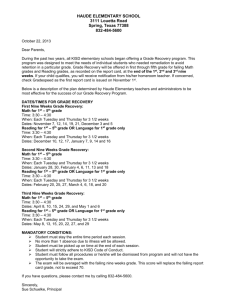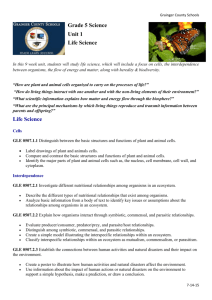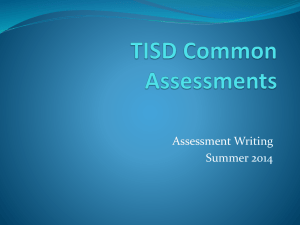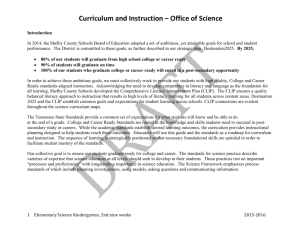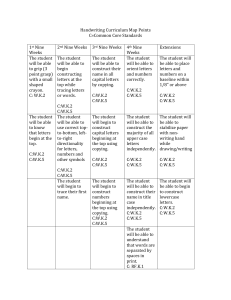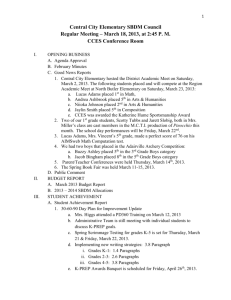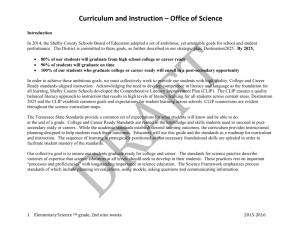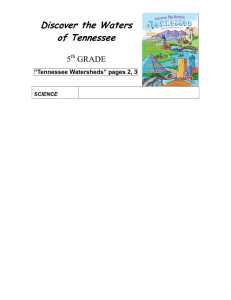Curriculum and Instruction – Office of Science
advertisement
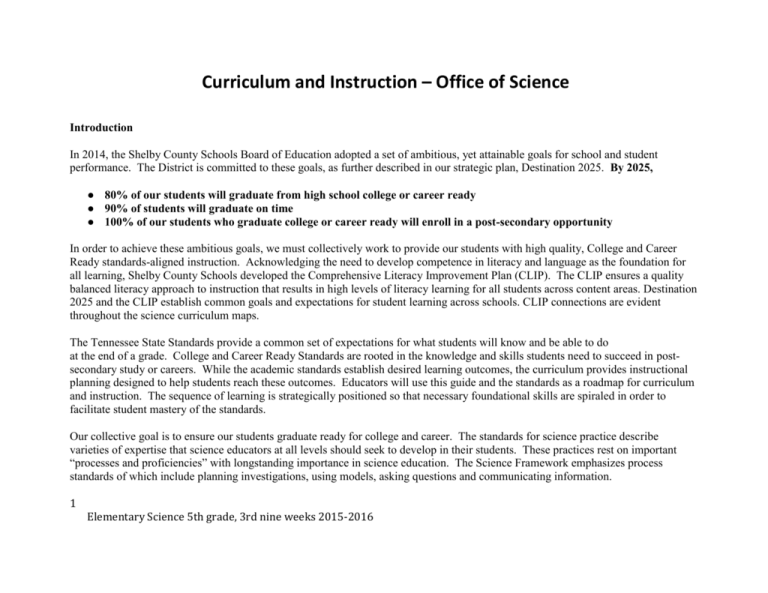
Curriculum and Instruction – Office of Science Introduction In 2014, the Shelby County Schools Board of Education adopted a set of ambitious, yet attainable goals for school and student performance. The District is committed to these goals, as further described in our strategic plan, Destination 2025. By 2025, ● 80% of our students will graduate from high school college or career ready ● 90% of students will graduate on time ● 100% of our students who graduate college or career ready will enroll in a post-secondary opportunity In order to achieve these ambitious goals, we must collectively work to provide our students with high quality, College and Career Ready standards-aligned instruction. Acknowledging the need to develop competence in literacy and language as the foundation for all learning, Shelby County Schools developed the Comprehensive Literacy Improvement Plan (CLIP). The CLIP ensures a quality balanced literacy approach to instruction that results in high levels of literacy learning for all students across content areas. Destination 2025 and the CLIP establish common goals and expectations for student learning across schools. CLIP connections are evident throughout the science curriculum maps. The Tennessee State Standards provide a common set of expectations for what students will know and be able to do at the end of a grade. College and Career Ready Standards are rooted in the knowledge and skills students need to succeed in postsecondary study or careers. While the academic standards establish desired learning outcomes, the curriculum provides instructional planning designed to help students reach these outcomes. Educators will use this guide and the standards as a roadmap for curriculum and instruction. The sequence of learning is strategically positioned so that necessary foundational skills are spiraled in order to facilitate student mastery of the standards. Our collective goal is to ensure our students graduate ready for college and career. The standards for science practice describe varieties of expertise that science educators at all levels should seek to develop in their students. These practices rest on important “processes and proficiencies” with longstanding importance in science education. The Science Framework emphasizes process standards of which include planning investigations, using models, asking questions and communicating information. 1 Elementary Science 5th grade, 3rd nine weeks 2015-2016 Curriculum and Instruction – Office of Science Construct explanations and design solution Obtain, evaluate, and communicate information Engage in argument 2 Ask questions and define problems Patterns Develop and use models Practices in Science Use math, technology, and computational thinking Plan and carry out investigations Cause and Effect Stability and change Analyze and interpret data Energy and matter Systems and system models Cross Cutting Concepts Elementary Science 5th grade, 3rd nine weeks 2015-2016 Curriculum and Instruction – Office of Science Crosscutting concepts have value because they provide students with connections and intellectual tools that are related across the differing areas of disciplinary content and can enrich their application of practices and their understanding of core ideas. Throughout the year, students should continue to develop proficiency with the eight science practices. Crosscutting concepts can help students better understand core ideas in science and engineering. When students encounter new phenomena, whether in a science lab, field trip, or on their own, they need mental tools to help engage in and come to understand the phenomena from a scientific point of view. Familiarity with crosscutting concepts can provide that perspective. A next step might be to simplify the phenomenon by thinking of it as a system and modeling its components and how they interact. In some cases it would be useful to study how energy and matter flow through the system, or to study how structure affects function (or malfunction). These preliminary studies may suggest explanations for the phenomena, which could be checked by predicting patterns that might emerge if the explanation is correct, and matching those predictions with those observed in the real world. Science Curriculum Maps This curriculum map is designed to help teachers make effective decisions about what science content to teach so that, our students will reach Destination 2025. To reach our collective student achievement goals, we know that teachers must change their instructional practice in alignment with the three College and Career Ready shifts in instruction for science. To ensure that all student will be taught science content and processes in a comprehensive, consistent, and coherent manner, Science Curriculum Maps are provided. Foundation texts for the maps include Shelby County Schools Framework for Standards Based Curriculum, Science Curriculum Frameworks-K-12 (State of Tennessee Board of Education, and National Science Education Standards). Teachers function most effectively and students learn best within an “aligned” curriculum delivery system. An aligned system begins with a concerted effort to implement the state curriculum frameworks. Many districts have developed curriculum guides built around these frameworks to ensure that what is taught in particular grades and courses is closely linked with student Learning Expectations found in the state standards. Classroom teachers’ use these locally generated curriculum guides to plan and implement their individual grade or course Pacing Guides. Expectations for student performance are clear and carefully tied to daily instructional events and classroom assessment practices. In theory, a fully aligned system closes the loop between state standards and student learning. 3 Elementary Science 5th grade, 3rd nine weeks 2015-2016 Curriculum and Instruction – Office of Science Additionally, a coherent instructional/assessment system offers the potential for heightening student learning as reflected by their performance on state-mandated standardized tests. Our collective goal is to ensure our students graduate ready for college and career. Most of the elements found in the state Curriculum Frameworks were incorporated into the curriculum mapping materials prepared by Shelby County Schools. Additional features were included to add clarity and to offer avenues that could assist teacher in developing grade level lessons. A district-wide, K-12, standards-based curriculum is implemented in science. This curriculum is articulated in the form of individual SCS curriculum maps for each grade and subject. These SCS curriculum maps enable the district to implement a single curriculum that emphasizes specific standards. Since Shelby County has a high rate of mobility among the student population, the SCS curriculum maps ensure that all students receive the same program of high-level instructional content and academic expectations, regardless of which school they attend. The utilization of a district-wide standards-based curricular program ensures that students in SCS are engaged in hands-on inquiry based activities as teachers implement the curriculum maps. 4 Elementary Science 5th grade, 3rd nine weeks 2015-2016 Curriculum and Instruction – Office of Science 5th Grade 3rd nine weeks: Focus: Physical Science: Matter Unit 5.3.1 Standard- Matter Time Frame (5 Weeks) (Text in blue are hyperlinked to suggested resources) I Can Statements: ● ● ● ● I can develop a model to describe that matter is made of particles too small to be seen. [Clarification Statement: Examples of evidence could include adding air to expand a basketball, compressing air in a syringe, dissolving sugar in water, and evaporating salt water.] I can measure and graph quantities to provide evidence that regardless of the type of change that occurs when heating, cooling, or mixing substances, the total weight of matter is conserved. [Clarification Statement: Examples of reactions or changes could include phase changes, dissolving, and mixing that form new substances.] I can make observations and measurements to identify materials based on their properties. [Clarification Statement: Examples of materials to be identified could include baking soda and other powders, metals, minerals, and liquids. Examples of properties could include color, hardness, reflectivity, electrical conductivity, thermal conductivity, response to magnetic forces, and solubility; density is not intended as an identifiable property.] I can conduct an investigation to determine whether the mixing of two or more substances results in new substances. Standards Learning Outcomes 0507.9.1 Distinguish between physical Observe and measure the simple chemical and chemical properties. properties of common substances. 0507.9.2 Describe the differences among freezing, melting, and evaporation. Design and conduct an experiment to demonstrate how various types of matter freeze, melt, or evaporate. 0507.9.3 Describe factors that influence the rate at which different types of material freeze, melt, or evaporate. Investigate factors that affect the rate at which various materials freeze, melt, or evaporate. Tasks & Resources Macmillan/McGraw-Hill Academic Vocabulary Chapter 5- pp. 254-305 Tier 1: acids /bases, contract/expand, Labs and Investigations Tier 2: insulator, light reflection, magnetic field Explore Lab page 259 “How can you know what is “inside’ matter? Alternative Explore: What’s in the box? Page 259 Supplemental Assessments: www.scssciencedepartment.weebly.com 5 CLIP Connection Elementary Science 5th grade, 3rd nine weeks 2015-2016 Tier 3: radiation conductor, chemical properties, conduction, chemical change convection, kinetic energy, potential energy, states of matter Curriculum and Instruction – Office of Science Fifth grade Closer Look assessment book Literacy Connection Matter is Everywhere Additional 5.3.1 Resources toolbox Online Resources: ● http://www.chem4kids.com/files/matter_intro.html ● http://idahoptv.org/sciencetrek/topics/matter/facts.cfm ● http://studyjams.scholastic.com/studyjams/jams/science/matter/properties-of-matter.htm ● Unit III assessment www.scssciencedepartment.weebly.com password: energy Pink Palace: Unit 5.3.1 Matter Pink Palace Museum Field Trips Labs: It Bubbles, It Fizzes, It’s Chemistry 6 Elementary Science 5th grade, 3rd nine weeks 2015-2016 Curriculum and Instruction – Office of Science Unit 5.3.2 Focus: Physical Science Standard: Motion & Stability – Forces & Interactions Time Frame: (4 Weeks) (Text in blue are hyperlinked to suggested resources) I Can Statements: ● ● ● ● I can support an argument that the gravitational forces are exerted by Earth on objects is directed down. [Clarification Statement: “Down” is a local description of the direction that points toward the center of the spherical Earth.] Apply Newton’s Third Law to design a solution to a problem involving the motion of two colliding objects. [Clarification Statement: Examples of practical problems could include the impact of collisions between two cars, between a car and stationary objects, and between a meteor and a space vehicle.] Plan an investigation to provide evidence that the change in an object’s motion depends on the sum of the forces on the object and the mass of the object. [Clarification Statement: Emphasis is on balanced (Newton’s First Law) and unbalanced forces in a system, qualitative comparisons of forces, mass and changes in motion (Newton’s Second Law), frame of reference, and specification of units.] Construct and present arguments using evidence to support the claim that gravitational interactions are attractive and depend on the masses of interacting objects. [Clarification Statement: Examples of evidence for arguments could include data generated from simulations or digital tools; and charts displaying mass, strength of interaction, distance from the Sun, and orbital periods of objects within the solar system.] Standards Learning Outcomes 0507.11.1 Explain the relationship that exist 0507.11.1 Design an investigation, collect data and among mass, force, and distance traveled. draw conclusions about the relationship among 0507.12.1 Recognize that the earth attracts mass, force, and distance traveled. objects without touching them. 0507.12.2 Identify the force that causes objects to fall to the earth. 0507.12.3 Use data to determine how shape affects the rate at which a material falls to earth. 7 0507.12.1 Recognize that the earth attracts objects without directly touching them. 0507.12.2 Investigate how the shape of an object influences the way that it falls toward the earth. Textbook Resources Textbook materials: Academic Vocabulary MacMillan/McGraw-Hill Tier 1: element, gravity, motion, position, speed, Chapter 6, pp. 306-361 Tier 2: velocity, acceleration, momentum Lab investigations: Quick lab: How is speed measured? 0507.12.3 Provide examples of how forces can act at Page 311 Model Roller Coaster Motion a distance. Elementary Science 5th grade, 3rd nine weeks 2015-2016 CLIP Connection Tier 3: atom, nucleus, proton, neutron, electron, molecule, potential energy, Kinetic energy, conduction, convection, radiation Curriculum and Instruction – Office of Science Alternative Explore: Literacy Connections: How fast will it sink? Pg. 311 Water and Waves Supplemental assessments: Free Transfer www.scssciencedepartment.weebly.com Additional 5.3.2 Resource Toolbox Online Resources ● http://www.macmillanmh.com/science/2008/student/na/grade5/g5_ch9.html ● http://studyjams.scholastic.com/studyjams/jams/science/forces-and-motion/force-and-motion.htm ● http://www.kidsdiscover.com/spotlight/force-motion-kids/ ● ● http://www.learner.org/workshops/force/workshop2/ http://www.kidsdiscover.com/spotlight/force-motion-kids/ Unit III assessment www.scssciencedepartment.weebly.com password: energy 8 Elementary Science 5th grade, 3rd nine weeks 2015-2016
